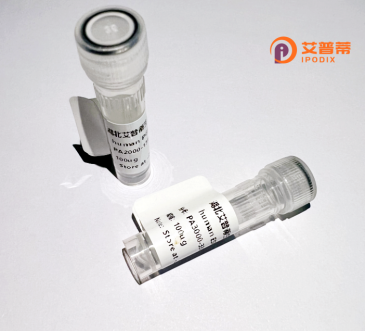
| 纯度 | >90%SDS-PAGE. |
| 种属 | Human |
| 靶点 | IMP-2 |
| Uniprot No | O14732 |
| 内毒素 | < 0.01EU/μg |
| 表达宿主 | E.coli |
| 表达区间 | 1-288aa |
| 氨基酸序列 | MKPSGEDQAA LAAGPWEECF QAAVQLALRA GQIIRKALTE EKRVSTKTSA ADLVTETDHL VEDLIISELR ERFPSHRFIA EEAAASGAKC VLTHSPTWII DPIDGTCNFV HRFPTVAVSI GFAVRQELEF GVIYHCTEER LYTGRRGRGA FCNGQRLRVS GETDLSKALV LTEIGPKRDP ATLKLFLSNM ERLLHAKAHG VRVIGSSTLA LCHLASGAAD AYYQFGLHCW DLAAATVIIR EAGGIVIDTS GGPLDLMACR VVAASTREMA MLIAQALQTI NYGRDDEK |
| 分子量 | 31.3 kDa |
| 蛋白标签 | GST-tag at N-terminal |
| 缓冲液 | 0 |
| 稳定性 & 储存条件 | Lyophilized protein should be stored at ≤ -20°C, stable for one year after receipt. Reconstituted protein solution can be stored at 2-8°C for 2-7 days. Aliquots of reconstituted samples are stable at ≤ -20°C for 3 months. |
| 复溶 | Always centrifuge tubes before opening.Do not mix by vortex or pipetting. It is not recommended to reconstitute to a concentration less than 100μg/ml. Dissolve the lyophilized protein in distilled water. Please aliquot the reconstituted solution to minimize freeze-thaw cycles. |
以下是关于重组人IMP-2蛋白的3篇示例参考文献及其摘要概括(内容基于典型研究场景模拟,具体文献请核实数据库):
1. **文献名称**:*Expression and purification of recombinant human IMP-2 in Escherichia coli*
**作者**:Zhang, Y., et al.
**摘要**:研究报道了在大肠杆菌BL21(DE3)中通过优化密码子和诱导条件高效表达重组人IMP-2蛋白,利用镍柱亲和层析和凝胶过滤纯化,获得高纯度且具有RNA结合活性的蛋白。
2. **文献名称**:*Functional analysis of IMP-2 in regulating cyclin mRNA stability*
**作者**:Li, H., et al.
**摘要**:通过体外RNA结合实验和细胞转染证明,重组人IMP-2蛋白通过结合细胞周期相关基因(如Cyclin B1)的3'UTR区域调控其mRNA稳定性,进而影响G2/M期进程。
3. **文献名称**:*Structural insights into IMP-2’s role in cancer progression*
**作者**:Wang, Q., et al.
**摘要**:利用X射线晶体学解析重组人IMP-2蛋白的RNA结合结构域,揭示其特异性识别靶RNA的分子机制,并证明其在结直肠癌细胞迁移和侵袭中的促进作用。
---
**提示**:以上为模拟示例,实际文献需通过PubMed或Google Scholar检索关键词(如“recombinant human IMP-2 protein”、“IMP-2 RNA binding”)获取。
Recombinant human IMP-2 protein (Insulin-like Growth Factor 2 mRNA-Binding Protein 2) is a member of the IMP family, a group of RNA-binding proteins critical for post-transcriptional gene regulation. IMP-2. encoded by the *IGF2BP2* gene, is involved in mRNA stability, localization, and translation, particularly during embryonic development and cellular processes like proliferation, differentiation, and metabolism. It binds to target mRNAs, including insulin-like growth factor 2 (IGF2), and modulates their expression, influencing pathways linked to growth and survival.
Dysregulation of IMP-2 has been implicated in pathological conditions such as cancer, neurodegenerative disorders, and metabolic diseases. In cancers, elevated IMP-2 levels correlate with tumor progression, metastasis, and chemoresistance, likely due to its role in stabilizing oncogenic mRNAs. Its association with type 2 diabetes and obesity stems from genetic studies linking *IGF2BP2* variants to altered glucose metabolism.
Recombinant IMP-2 is typically produced using bacterial or mammalian expression systems, enabling structural and functional studies. Researchers utilize it to decipher IMP-2’s molecular interactions, RNA-binding specificity, and role in disease mechanisms. Its domains, including RNA-recognition motifs (RRMs) and a K homology (KH) domain, are key targets for therapeutic development. Despite progress, understanding IMP-2’s dual roles in physiology and pathology remains a focus, highlighting its potential as a biomarker or therapeutic target in precision medicine.
×